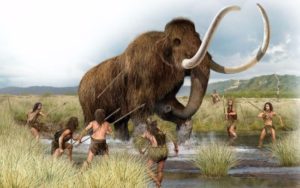Interesting facts about mammoths
 These shaggy giants, the mammoths who once trampled the earth, still raise a lot of questions. Being very interesting animals, they existed on our planet for an infinitely long number of years, until they finally disappeared. The reasons for their extinction are still unclear, despite the fact that thanks to the permafrost, scientists were able to find many well-preserved remains of these animals.
These shaggy giants, the mammoths who once trampled the earth, still raise a lot of questions. Being very interesting animals, they existed on our planet for an infinitely long number of years, until they finally disappeared. The reasons for their extinction are still unclear, despite the fact that thanks to the permafrost, scientists were able to find many well-preserved remains of these animals.
These animals appeared about 1.5-1.6 million years ago.
Worldwide, mammoths died out about 8-10 thousand years ago, but on the Russian island of Wrangel their dwarf subspecies existed 3.5-4 thousand years ago.
These animals still existed when the ancient Egyptians and Maya built their pyramids.
Since hunting for elephants is banned everywhere, most ivory products are actually made from mammoth tusks.
Since the dinosaurs became extinct, it was the mammoths who were the largest inhabitants of land on our planet.
Some of the remains of mammoths discovered in the permafrost surprise scientists – not completely digested food remained in the stomachs of animals, suggesting that death had suddenly occurred. This goes against the theory that primitive people destroyed mammoths.
In general, mammoths were comparable in size to elephants, but their North American subspecies reached a height of 5.5 meters and a mass of up to 12 tons, which is more than any elephant.
Primitive hunters often hunted these animals, and not only for the sake of meat, but also for the hides and bones. And since they learned how to dig traps for them, the hunting process has become much safer.
At about the same time as mammoths, 34 more kinds of animals died out, that is, very, very many different species. The reasons for the mass and rapid extinction are still not clear.
The habitat of these animals began to decline after warming on Earth, that is, about 15 thousand years ago.
The mammoths had a hump on their backs, which the elephants do not have. They accumulated fat reserves in it, which helped to survive the hungry times, just like camels do.
The dwarf subspecies of the mammoth from Wrangel Island was small. The adult animal weighed only about 1 ton.
These animals ate coarse plant food, and their flat teeth from such a menu quickly fell into disrepair. But as they wear out, new ones have grown to replace them. They could be updated 5-6 times, just as it happens with elephants.
There are still many mammoth bodies in the permafrost, but if the topsoil thaws for some reason, they quickly decompose. Sometimes they are also eaten by scavengers.
Researchers of 18-19 centuries wrote in their notes that their dogs willingly ate the meat of the mammoths they discovered.
In particularly hungry winters, mammoths, in the absence of more suitable vegetation, fed on tree bark.
Primitive people in their rock paintings depicted these animals more often than any other.
From the cold of the mammoths defended not only a shaggy skin, but also a thick layer of fat beneath it. In thickness, it reached 8-10 centimeters depending on the part of the body and the fatness of a particular animal.
Moscow is one of the few cities in the world whose museums have completely complete mammoth skeletons. There are three of them in the Russian capital.
The weight of the tusk of an adult mammoth could reach 100 kg, and the length – 3.5-4 meters.
According to Chukchi folk legends, mammoths are evil spirits living underground.
Every day, the mammoths ate about half as much food as modern elephants eat.
The tusks of these animals are stronger than elephants.
Scientists intend to revive the mammoths, and Russian and American scientists go in different ways. In one of the variants, it is supposed to fertilize a female elephant with an artificially restored mammoth embryo, obtained by decoding the DNA of this animal.
In Magadan and Salekhard there are life-size monuments to the mammoth.
During life, these animals were huddled in compact herds of 5-15 individuals.
Mammoth bones that have lain for thousands of years in permafrost, quickly lose their strength under the influence of oxygen and sunlight. To prevent this from happening, they are specially treated. But their tusks after such mineralization acquire the strength of hardened metal.
Indian elephants, not African, are considered to be the ancestors of the mammoths.
Images of these animals are found on the arms of three cities in the world. Two of them are in Yakutia, and another one is in Germany.
Simultaneously with the mammoths, the mastodons died out. They were similar to them, and also had tusks and a trunk, but in size they were inferior even to modern elephants.



























